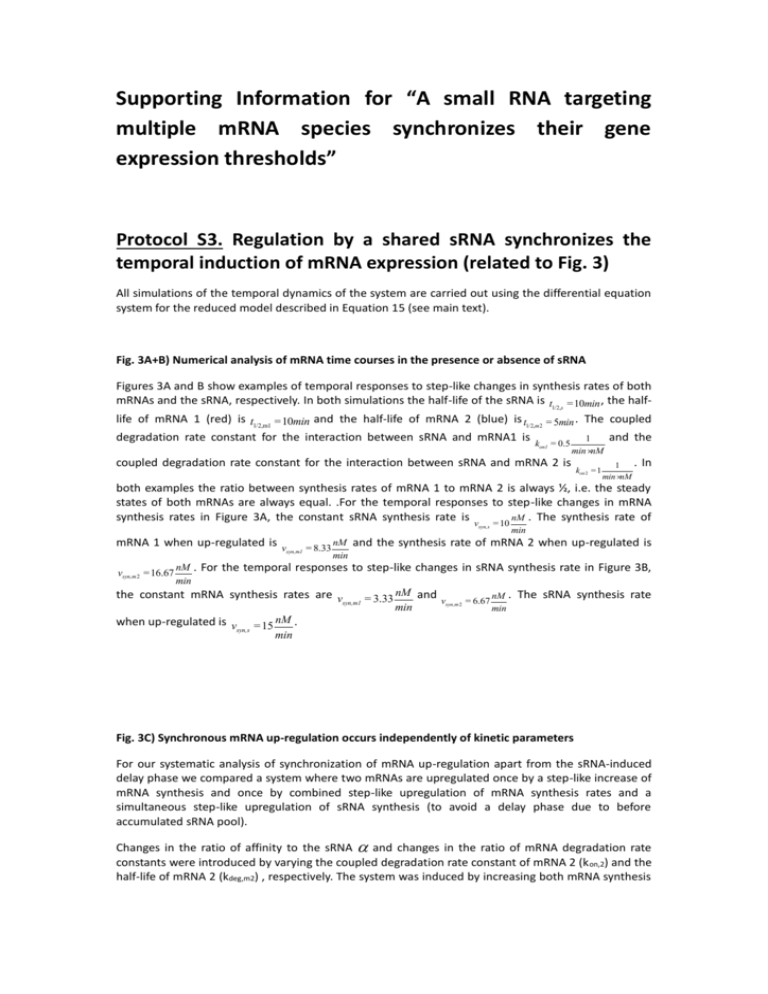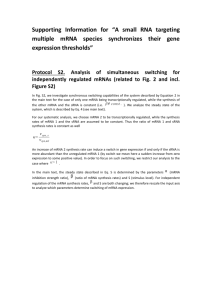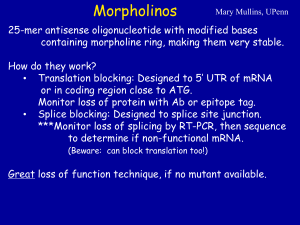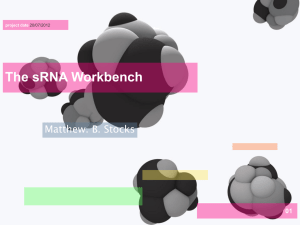Protocol S3. Regulation by a shared sRNA synchronizes
advertisement

Supporting Information for “A small RNA targeting multiple mRNA species synchronizes their gene expression thresholds” Protocol S3. Regulation by a shared sRNA synchronizes the temporal induction of mRNA expression (related to Fig. 3) All simulations of the temporal dynamics of the system are carried out using the differential equation system for the reduced model described in Equation 15 (see main text). Fig. 3A+B) Numerical analysis of mRNA time courses in the presence or absence of sRNA Figures 3A and B show examples of temporal responses to step-like changes in synthesis rates of both mRNAs and the sRNA, respectively. In both simulations the half-life of the sRNA is t1/2,s =10min , the halflife of mRNA 1 (red) is t1/2,m1 =10min and the half-life of mRNA 2 (blue) is t1/2,m2 = 5min . The coupled degradation rate constant for the interaction between sRNA and mRNA1 is k = 0.5 1 and the on1 min × nM coupled degradation rate constant for the interaction between sRNA and mRNA 2 is kon2 =1 . 1 min × nM In both examples the ratio between synthesis rates of mRNA 1 to mRNA 2 is always ½, i.e. the steady states of both mRNAs are always equal. .For the temporal responses to step-like changes in mRNA synthesis rates in Figure 3A, the constant sRNA synthesis rate is v =10 nM . The synthesis rate of syn,s mRNA 1 when up-regulated is vsyn,m2 =16.67 vsyn,m1 = 8.33 nM min min and the synthesis rate of mRNA 2 when up-regulated is nM . For the temporal responses to step-like changes in sRNA synthesis rate in Figure 3B, min nM and the constant mRNA synthesis rates are v syn,m1 = 3.33 min vsyn,m2 = 6.67 nM . min The sRNA synthesis rate when up-regulated is v =15 nM . syn,s min Fig. 3C) Synchronous mRNA up-regulation occurs independently of kinetic parameters For our systematic analysis of synchronization of mRNA up-regulation apart from the sRNA-induced delay phase we compared a system where two mRNAs are upregulated once by a step-like increase of mRNA synthesis and once by combined step-like upregulation of mRNA synthesis rates and a simultaneous step-like upregulation of sRNA synthesis (to avoid a delay phase due to before accumulated sRNA pool). Changes in the ratio of affinity to the sRNA a and changes in the ratio of mRNA degradation rate constants were introduced by varying the coupled degradation rate constant of mRNA 2 (k on,2) and the half-life of mRNA 2 (kdeg,m2) , respectively. The system was induced by increasing both mRNA synthesis nM to rates in a step-like manner at t = 0 min from v syn,m1 ( t < 0min ) = vsyn,m2 ( t < 0min ) = 0 min nM . Further, for the sRNA regulated case, at t = 0 min sRNA vsyn,m1 ( t > 0min) = vsyn,m2 ( t > 0min) =12.5 min synthesis was increased in a step-like manner from zero to v (t > 0 min) =10 nM . The response time of syn,s min mRNA, defined as the half-maximal time, t50, was quantified by determining the time when mRNA levels had reached 50% of the difference between initial and final steady state levels. Synchronous temporal upregulation by sRNA regulation was quantified using the ratio of 50% threshold time differences between the sRNA regulated and the sRNA unregulated state (Eq. 16; main text). Fig. 3D) Synchronous mRNA down-regulation occurs mostly independent of kinetic parameters For the systematic analysis of mRNA shutdown we compared a system where two mRNAs are downregulated once by shutdown of mRNA synthesis and once by combined shutdown of mRNA synthesis and simultaneous step-like upregulation of sRNA synthesis. Changes in the ratio of affinity to the sRNA a and changes in the ratio of mRNA degradation rate constants were introduced by varying the coupled degradation rate constant of mRNA 2 (k on,2) and the half-life of mRNA 2 (kdeg,m2) , respectively. The shutdown of the system was induced by decreasing both mRNA synthesis rates in a nM (system had reached steady step-like manner at t = 0 min from v t < 0min = v t < 0min = 5 syn,m1 ( ) syn,m2 ( ) min nM . state given synthesis rates for t < 0 min before switching) to v (t > 0min) = v syn,m1 syn,m2 ( t > 0min ) = 0 min Further, for the sRNA regulated case, at t = 0 min sRNA synthesis was increased in a step-like manner from zero to v (t > 0 min) = 20 nM . Therefore the system was induced to switch from an expressed to syn,s min an repressed state. The response time of mRNA, defined as the half-maximal time, t50, was quantified by determining the time when mRNA levels had reached 50% of the difference between initial and final steady state levels. Synchronous temporal upregulation by sRNA regulation was quantified using the ratio of 50% threshold time differences between the sRNA regulated and the sRNA unregulated state (Eq. 16; main text). Fig. 3E) Regulation by a shared sRNA regulation establishes a delay frame for mRNA induction To show synchronization of temporal thresholds for gene expression despite uncoordinated upregulation of mRNA synthesis rates, we simulate a system with constant sRNA synthesis, one mRNA also being constantly expressed and three other mRNAs being consecutively up-regulated. Synthesis rates, up-regulation times, half-lives and coupled degradation rate constants are: constant nM nM ; constant mRNA 1 synthesis rate: vsyn,m1 = 60 ; mRNA 2 min min nM synthesis rate after up-regulation at t = 0 min: vsyn,m2 ( t > 0min) = 90 ; mRNA 3 synthesis rate min nM after up-regulation at t = 10 min: vsyn,m3 ( t >10min) = 80 ; mRNA 4 synthesis rate after upmin nM regulation at t = 20 min: vsyn,m4 ( t > 20min) = 70 ; sRNA half-life time: t 1/2, s= 20min ;mRNA min sRNA synthesis rate: vsyn,s =100 half-life times: t 1/2,m1 =t1/ 2,m2 =t 1/2,m3 =t1/2,m4 = 10 min ; coupled degradation rate constants for all mRNAs: . 1 kon1 = kon2 = kon3 = kon4 = 10 min nM









